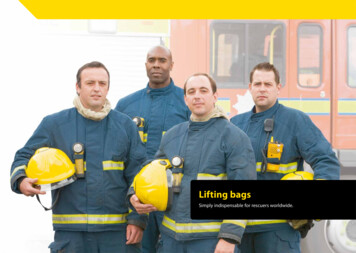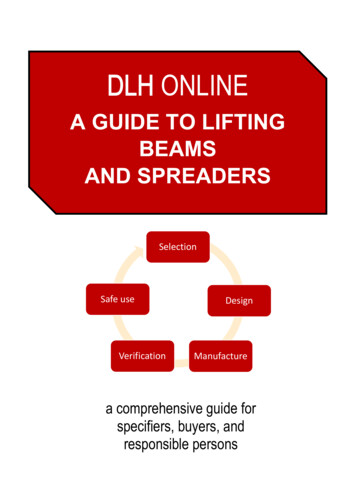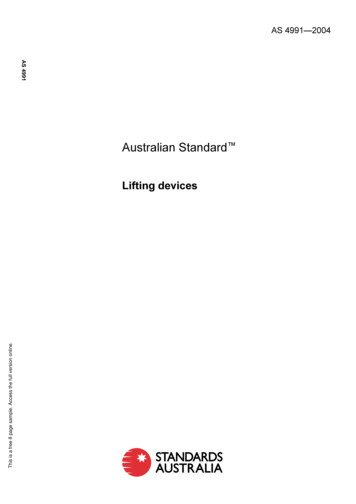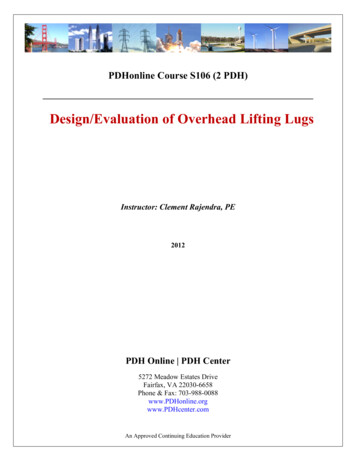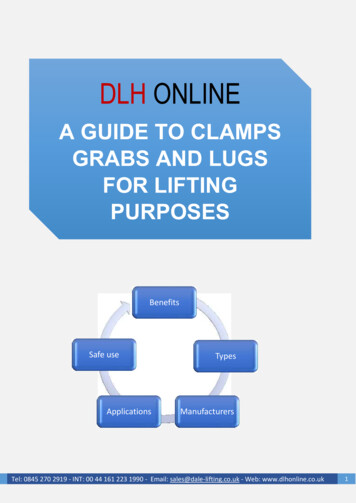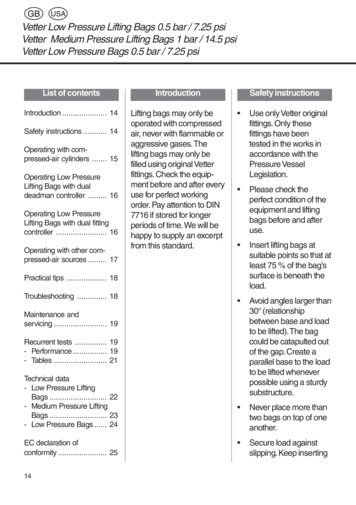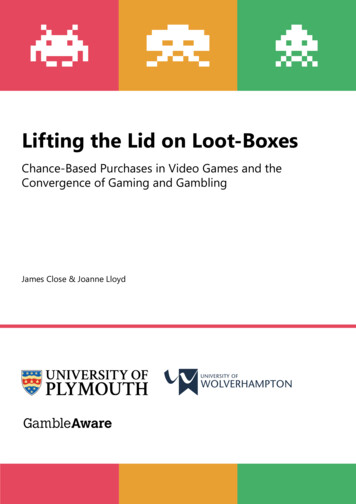
Transcription
Lifting the Lid on Loot-BoxesChance-Based Purchases in Video Games and theConvergence of Gaming and GamblingJames Close & Joanne Lloyd
Lifting the Lid on Loot-BoxesChance-Based Purchases in Video Games and theConvergence of Gaming and GamblingDr James CloseSenior Research Fellow. Faculty of Health, University of Plymouthjames.close@plymouth.ac.ukDr Joanne LloydSenior Lecturer in Psychology. Faculty of Education Health & Wellbeing, University of WolverhamptonJoanne.Lloyd@wlv.ac.ukCOMMISSIONED BY:Gamble AwarePennine Place, 2a Charing Cross Rd, London WC2H 0HFbegambleaware.orgAcknowledgements and disclaimer. This project was funded by GambleAware. The views expressedin this publication are those of the authors alone and not necessarily those of GambleAware. The fullresearch team, all of whom contributed to the Gamble-Aware funded research that informed thisdocument, are: Dr Helen Lloyd, Dr James Close, Dr Oliver Smith and Dr Stuart Spicer (University ofPlymouth); Dr Joanne Lloyd, Dr Laura Louise Nicklin, Dr Chris Fullwood and Prof Maria Uther (Universityof Wolverhampton); Dr Chris Stiff (University of Keele); Dr Thomas Raymen (Northumbria University) andDr Jonathan Parke (Sophro Ltd.).Copyright notice. The author acknowledges that the copyright of all images and screenshots of videogames used in this paper are retained by their respective copyright holders. The author uses thesecopyrighted materials either under licence or for the purposes of research, criticism or review under thefair dealing provisions of copyright law in accordance with Sections 29(1) and 30(1) of the UK Copyright,Designs and Patents Act 1988.
Executive SummaryExecutive Summary1. Introduction & BackgroundLoot boxes are purchasable video game content with randomised rewards. Due to structural andpsychological similarities with gambling, they have come under increasing media, academic and legalscrutiny. The UK government is currently reviewing evidence on loot boxes, which will be consideredin the forthcoming review of the Gambling Act 2005.In January 2020, we were commissioned by GambleAware to conduct a package of research intoloot boxes. This interdisciplinary collaboration between the University of Wolverhampton and theUniversity of Plymouth draws from our backgrounds in gambling, gaming, psychology and healthcare.It aims to inform future UK policy on loot boxes with a robust, evidence-based approach.The goals of our project are to investigate the psychological profiles of young people and adults whobuy loot boxes, studying their purchasing motivations, and any links with potential harms. These couldinclude unsustainable spending, lower wellbeing, problem gambling and problem video gaming.The first section of this document, Introduction and background, presents a primer on loot boxes,revealing how they evolved from Asian ‘free to play’ games, before diversifying into every availablegenre, including many big-budget ‘AAA’ titles. This is followed by subsequent sections (summarisedbelow) that present our emerging findings, contextualised within the current evidence around lootboxes, before concluding with implications for future policy.Key Questions What evidence is there for links between loot boxes and problem gaming or gambling?What are the player motivations for loot box purchasing?Does loot-box purchasing lead to harm, financial or otherwise?Are any groups, such as young people or children, particularly at risk?If so, what can be done about it?Lifting the Lid on Loot Boxes - Chance-based purchases in videogames and the convergence of gaming and gambling1
Executive Summary2. Loot boxes, Problem Gambling and Problem Video GamingOne of the most influential academic publications on loot boxes was a 2018 survey of gamers bythe UK researchers David Zendle and Paul Cairns1. This identified an association between loot boxpurchasing and problem gambling scores, as measured by the Problem Gambling Severity Index(PGSI). Similar surveys soon followed, prompting us to carry out a systematic review establishingtheir robustness, reproducibility and effect sizes. Our review demonstrates that relationships betweenloot box engagement and problem gambling have been robustly verified in around a dozen studies.These draw from various nationalities and cohorts, and now include pre-registered and nationallyrepresentative samples.The effect sizes are ‘moderate’ – a magnitude which bears statistical and practical relevance: they arestronger than or comparable with well-established associations between problem gambling and otherco-morbidities, such as depression, alcohol and drug dependencies. Similar relationships have beenestablished with problem video gaming.3. Motivations for purchaseRelationships between loot box engagement and problematic gambling are now well demonstrated,but they tell us nothing about the underlying motivations for purchase in the first place. At themoment, there has been almost no academic literature published about the motivations for loot boxpurchasing. This contrasts with gambling research, where we know gambling is driven by a multitudeof overlapping motivations.Without similar information about loot boxes, it is difficult to understand the mechanisms via whichany harms might manifest. We therefore conducted a series of in-depth interviews with a diversesample of regular loot box purchasers from across the UK.This revealed that motivations for loot box purchasing are embedded within a network of personal,social and gameplay factors, and often overlap with motivations for purchasing other, nonrandomised in-game content (although there is typically more excitement associated with winning anitem within a loot box than with buying it from the in-game store).Such motivations include both social interactions (such as gaining status and approval, or as part ofa group experience) and game-related motivations (such as improving performance, aesthetics orgameplay experience).Participants also purchased loot boxes because of a ‘fear of missing out’ either socially (e.g. on sharedexperiences around ‘unboxing’), financially (on promotions) or acquisitively (on items that are onlyavailable for a limited time). Within the cyberpsychological literature, ‘fear of missing out’ (abbreviatedto FoMO), typically refers specifically to anxiety about missing out on social (or social media)interactions whilst offline. Here, we define loot box-related ‘fear of missing out’ as the range of thingsour participants worried about missing if they did not engage with loot boxes.Furthermore, players are often nudged towards purchasing via a number of well-known psychologicaltechniques, such as endowment effects (by giving away ‘free’ loot boxes, but then charging foropening), price anchoring, special limited-time offers or items, and obfuscation of costs (i.e. viain-game currencies). Developers have openly discussed such approaches, where loot boxes (withtheir gambling-like structure) are just one architectural choice from a psychological playbook ofmonetisation strategies.Lifting the Lid on Loot Boxes - Chance-based purchases in videogames and the convergence of gaming and gambling2
Executive SummaryOur observations also highlight that the concept of ‘value’ extends beyond the legal ‘money’sworth’ definition. Instead, prized items in loot boxes can hold significant social or psychologicalcapital. Nonetheless, many gamers do ascribe discrete financial values to loot box contents – basedon purchase or resale price – suggesting that many loot boxes meet existing criteria for gamblingregulation.4. Problematic play? Loot boxes, financial harm and psychological harmTo investigate notions of financial harm, we conducted a secondary analysis of six open accessdatasets of loot box surveys, aggregating the freely available data2. The combined dataset comprisedof 7,767 loot box purchasers, and our analysis established that a disproportionate amount of revenueis derived from high-level spenders. For example, around 5% of loot box purchasers in our dataset(those spending more than around 70 / 100 per month, or local equivalent) generate around half ofindustry revenue from loot boxes. Moreover, almost one third of these top 5% of spenders fall into the‘problem gambler’ category.Conversely, there is no evidence that higher loot box spend is correlated with higher earnings. Ourresearch therefore demonstrates that games developers, unwittingly or not, appear to be generatingoutsized loot box profits from at-risk individuals (these are likely to include both people withgambling problems or problematic patterns of video gaming) – but not from wealthy gamers.At present, there is a paucity of evidence investigating links between loot box engagement andwellbeing or psychological distress. Any preliminary evidence has been cautiously interpreted, withmixed results. However, harms associated with loot boxes (either financial or psychological) areliable to have a disproportionate effect on specific cohorts of gamers. We present data from our ownbrief screen of around 14,000 UK gamers, which confirms that loot box engagement is linked with anumber of demographic factors including male sex, younger age, and lower educational attainment.5. Loot box defences, industry self-regulation and previouspolicy responsesWe note that a chorus of voices are calling for the UK to legislate loot boxes as gambling, includingacademic researchers3,4, the Department for Digital, Culture, Media and Sport (DCMS)5, the House ofLords Gambling Committee6, a number of influential charities7,8, and over 40,000 signatories of a recentpetition to the government9. There have been a number of responses to these growing calls for policyaction.First, there have been a series of arguments rallied in defence of loot boxes as an unproblematic,non-gambling activity. For example, loot boxes have been compared with earlier, unfounded videogame-related moral panics, such as links between video gaming and violence. However, these earliercontroversies were based on questionable, unrepeated evidence – which contrasts markedly with theloot box evidence. Loot boxes have also been defended as ‘surprise mechanics’ – no different, forexample, to a Kinder Egg. Such arguments, however, do not tally with well-established associationsbetween loot boxes and problematic gambling behaviour.Second, there have been some recent attempts at industry self-regulation. However, ‘odds disclosures’of loot boxes have sometimes been presented in a confusing and incomplete manner10, and theseattempts at corporate transparency remain opaque. Similarly, game labelling for loot boxes currentlyLifting the Lid on Loot Boxes - Chance-based purchases in videogames and the convergence of gaming and gambling3
Executive Summaryfall short of age restrictions, despite being regularly called for3,7,11,12. Nonetheless, age restrictions are,in any case, ignored by the majority of parents and children13,14.Third, there has been policy action on loot boxes from a number of jurisdictions, including China,Belgium and the Netherlands. However, these initial attempts to legislate loot boxes have sufferedfrom a series of shortcomings, including industry manoeuvring (i.e. to sidestep legislation) andinconsistent policy (i.e. they only mitigate risks associated with certain classes of loot boxes, such asthose with explicit ‘cash out’ features).6. Conclusions and recommendationsAny legislation regulating loot boxes will require careful consideration. Drawing from experiencesin other jurisdictions, we present a series of recommendations for future policy. Prospective policyshould include provisions for clear definitions of loot boxes, game labelling and age ratings, fulldisclosure of odds presented in an easy-to-understand way, spending limits and prices in realcurrency, and finally, obligations of gatekeepers (i.e. developers, distributors, content providers) forthe trade they enable and profit from.Finally, we conclude with a stark warning: in the rapidly evolving world of video gaming, legislationagainst loot boxes is liable to be quickly rendered anachronistic. Longer-term mitigation of risk –from the potential dangers of a broad range of psychological nudges, potentially liable to causeunsustainable levels of spending in vulnerable individuals – will require increased provision forconsumer protection, child-focused data protection policies, more research, and educational packagesthat mitigate against these dangers and harms.Lifting the Lid on Loot Boxes - Chance-based purchases in videogames and the convergence of gaming and gambling4
ContentsContentsExecutive summary11. Introduction and background6The biggest metagame in townThe loot box backlashSkins in the game69102. Loot boxes: problem gambling, problem gaming?133. Motivations for purchase194. Problematic play? Loot boxes, financial harm and psychological harm24Slot machine mechanicsLoot boxes and problem gamblingLoot boxes and problem video gamingFinancial harmPsychological harmWho is at risk?1315182426275. Loot box defences, industry self-regulation and previous policy responses 31Early loot box regulation: prescient or premature?Industry self-regulation: too little, too late?The conundrum of ‘money’s worth’3233346. Conclusions and recommendations37References41Appendix: methods49Concluding remarksMethods for section 2: literature reviewMethods for section 3: qualitative interviews around motivations for purchaseMethods for section 4: survey screen of loot box purchasersLifting the Lid on Loot Boxes - Chance-based purchases in videogames and the convergence of gaming and gambling394950505
Introduction & Background1. Introduction & BackgroundLoot boxes are often compared to baseball cards, trading card games or Kinder Eggs. This is areasonable analogy, since loot boxes trace their roots to the Japanese ‘gachapon’ – popular toyvending machines, named from the onomatopoeic ‘gacha’ sound of the hand-cranking, followed bythe reward-dropping ‘pon,’ as the random, capsule-encased toy plops down into the collection tray.This ‘payment for a random reward’ idea was first imported into video games back in 2004, appearingin the Japanese version of MapleStory.These digital ‘gacha’ quickly spread into many Southeast Asian video game titles. In a region doggedby heavy counterfeiting, these new types of payment enabled developers to give their titles away forfree, yet still accrue significant revenue15. The ‘freemium’ model of monetisation was born. It was notlong before Western developers took note. By the late 2000s, free-to-play (f2p) social games werebeing added to sites like MySpace and Facebook15, where gamers could purchase ‘mystery boxes’ ingames like Farmville, along with other non-randomised add-ons such as cows, sheep and corn. Thebusiness model enabled Zynga, the developer of Farmville, to accrue billions in revenue16.With the smartphone and tablet market revolutionising computing, these free-to-play games soonstarted hitting the expanding mobile market – and began revolutionising the way games weremonetised. Loot boxes were quickly retrofitted into many big-name ‘AAA’ titles, such as the ‘playerpacks’ of EA’s FIFA (in 2009) or the crates in the cartoonish first-person shooter Team Fortress 2 in2010. Within Team Fortress 2, these crates were given away for ‘free’ – but they could only be openedwith a purchasable ‘key.’Just like the earlier Asian titles, this ‘crate and key’ mechanic allowed Valve, the developer of TeamFortress 2, to release the game for free, leveraging network effects and rapidly swelling their activeplayer base. Team Fortress 2 was a huge success. Games such as The Lord of the Rings Online (in 2011)and Counter Strike: Global Offensive (in 2013) soon followed, offering loot boxes alongside other, nonrandom transactions.The Biggest Metagame in TownThese days, big-budget games have moved to a ‘service’ business model, with developers accruingongoing revenue via ongoing ‘season pass’ subscriptions or extra, downloadable digital content17.With gamers now accessing games though a variety of channels – desktops, laptops, consoles, tablets,smartphones18–20 – these innovations have enabled the game industry to become bigger than film andmusic combined21.“Games are really becoming services, where the launch of the game is just thebeginning of monetization, and the big money is having a large community, alarge user base, that keeps playing year after year after year.”– Lewis Ward, gaming analyst15.Within this evolving gaming ecosystem, loot boxes are just one possible monetisation option in whatthe developers call ‘the metagame.’ The metagame envelops the main game within a series of menuscreens, replete with options, customisations and game-related stats, enabling the player – dependingLifting the Lid on Loot Boxes - Chance-based purchases in videogames and the convergence of gaming and gambling6
Introduction & Backgroundon the game – to level-up characters; upgrade weapons; modify vehicles. Here, loot boxes sit in the‘item shop’ alongside other types of game-related purchases, and they can be found in just aboutevery genre of game, aimed at just about all types of people – shooters, role-plays, card games,action games.Loot boxes can come in various (virtual) shapes and sizes (see Figure 1), and have evolved to becomeincreasingly sophisticated17, for instance, they often incorporate exciting and drawn-out animationswhen revealing their contents, building a sense of anticipation (see Figure 2). They might be calledcrates, chests, packs, cases, bundles or cartons22–25. In some games, they might not be constrained tothe item shop, but are instead discovered in the virtual environment. Often, a game will offer lootboxes for free, encouraging later real-money purchases. They can provide items that improve in-gameperformance – so called ‘pay2win’ features, like a weapons upgrade or a faster, stronger character.Alternatively, the upgrade might be purely cosmetic – only changing the appearance of charactersor weapons.These transactions are not always ‘micro,’ either. In Overwatch, bundles of up to 50 loot boxes can bepurchased for 34.99. In FIFA, the most expensive ‘player packs’ can cost more than 15 each. For thisreason, we avoid using the term ‘microtransaction.’ It is often a misnomer.Figure 1. Various features of loot boxes.Lifting the Lid on Loot Boxes - Chance-based purchases in videogames and the convergence of gaming and gambling7
Introduction & BackgroundDue to the dizzying array of possible loot box configurations, many people disagree on what, exactly,constitutes a loot box. Our definition of loot boxes is therefore:Any game-related purchase with a chance-based outcomeOur definition does not preclude loot boxes that might also be given away as free offers, or earnedthrough gameplay – where, oftentimes, these ‘free’ loot boxes are designed to encourage futurepurchase. Whilst our definition might seem simple, it does carry some nuanced implications. SinceJanuary 2019, for example, Epic Games’ Fortnite has allowed players to view the contents of theirpiñata-style ‘loot boxes’ prior to purchase. Under our definition, these transactions are no longeractual loot boxes. The contents are known, not random.In contrast, some games not normally considered to have loot boxes are encapsulated by ourdefinition. For example, in Niantic’s Pokémon Go, extra ‘incubators’ can be purchased to acceleratethe hatching of ‘eggs,’ which increases the chance of hatching a desirable character**. Magazines suchas Eurogamer26 and Forbes27 have argued that Pokémon Go incubators are indeed a disguised form ofloot box, enabling developers to sidestep any regulations in a game widely played by children.Figure 2. The magical ‘reveal’ of a card pack and its collectiblecontents. Blizzard’s Hearthstone. Blizzard.** Technically, the ‘eggs and incubator’ model of Pokémon Go is a time-delayed ‘crate and key’ loot box. Theirsimilarity to traditional loot boxes is further obscured by the fact that a base number of incubators (the ‘keys’) areprovided for free – but, in fact, these are comparable to introductory/free loot boxes, often aimed at encouragingfuture purchase.Lifting the Lid on Loot Boxes - Chance-based purchases in videogames and the convergence of gaming and gambling8
Introduction & BackgroundThe loot box backlashThe history of loot boxes can be followed in a simple line graph. In Figure 3, we can see the surge inloot boxes around the years 2012-201519. By the middle of the decade, EA was reporting that around athird of their digital sales revenue – approximately 470 million – was derived from their loot box styleFIFA Ultimate Team packs28. By the end of the decade, the UK loot box market alone was estimated tobe worth 700 million7,29. By 2023, the global loot box market is predicted to rise to around 36 billion( 50 billion)29.Figure 3. The rise of loot boxes around 2012-2015 – but still in an upward trend. Graph shows the percentageof games played with various monetisation features, where cosmetic microtransactions blue; loot boxes green; pay to win red. Data is from desktop games available on the content provider, Steam, between 20102019. The blue and red lines refer to all types of transactions, not just loot boxes – and establish that cosmetictransactions dwarf ‘pay to win’ features. For original, See Zendle, 2020, The Changing Face of Desktop Video GameMonetisation19.When looking at Figure 3, the upward trajectory of loot boxes (in green) undergoes a distinctdownward blip around the end of 2017, falling from being present in 75% of games on Steam to 60%of games in a matter of months. At the time there were several forces starting to work against lootboxes, but this downtrend coincides almost precisely with the bungled release of Star WarsBattlefront II.The ‘pay to win’ loot box system in EA’s eagerly-awaited game was immediately derided by thegaming community. To compete, players were forced into either spending large sums of money or,alternatively, spending days of ‘grinding’ (performing repetitive tasks for gameplay advantage orloot) to earn boxes for free. For many gamers, the main gripe was that these loot boxes gave unfairadvantages to big spenders, and the high profile controversy – EA’s infamously woolly defence onReddit earned an entry in The Guinness Book of World Records as the ‘most hated’ post on the internetever30 – intensified the spotlight on loot boxes.Lifting the Lid on Loot Boxes - Chance-based purchases in videogames and the convergence of gaming and gambling9
Introduction & BackgroundThis is a turning point in the history of the loot box. EA’s stock fell 8% in the aftermath31, anddevelopers of other games – such as Middle-earth: Shadow of War – also started stripping loot boxesand pay to win features from their games32. But the backlash against loot boxes did not just influencethe fortunes of games developers – the controversy drew in academics, lawyers and politicians. Therewere other controversies, too, that started to work against loot boxes.Skins in the gameThe Battlefront II fiasco exposed the widespread unpopularity of loot boxes – but there were also aseries of more notorious scandals, which often encircled the game Counter-Strike: Global Offensive(CS:GO). Following the success of ‘crate and key’ loot boxes in Team Fortress 2 (TF2), Valve introducedrandom drops of weapons ‘crates’ into CS:GO in 2013. The items inside, however, remain unknown– and the crates can only be unlocked with a key purchased from the item shop. Once opened, thearmaments inside do not offer any gameplay advantage, but are instead known as ‘skins’: purelycosmetic finishes to the standard roster of weaponry.The game developer Valve promoted CS:GO as a centrepiece for the burgeoning eSports movement,which was transitioning into a professional sport, replete with tournaments in large, spectator filledarenas, often with substantial money prizes at stake33. Fairly quickly, the rarer, more attractive skinsbecame integrated into the culture of the game: desirable skins came to be referred to as ‘legendary’,synonymous with the kudos of talented, experienced players. Many players started trading skins (oftenobtained in loot boxes) for large sums of money, sometimes thousands of dollars34. Conversely, the‘consumer grade’ (i.e. default) skins were derided as the mark of a ‘noob’ (new player). These routinelytrade for less than nominal value – i.e. far less than the cost of unboxing.This ‘skin trading’ also happened in games like FIFA – with valuable players being traded for cash inillicit secondary markets – but with games like TF2 and CS:GO, the virtual economy was facilitated bythe launch of Valve’s Steam Community Market. This marketplace fluidly integrated trade into Steam,the world’s largest PC game distribution platform35. The marketplace allows players to seamlessly tradedigital assets for funds in their Steam wallet, with Valve collecting a 15% fee from each transaction.There are, however, limits to this trade. With the lack of direct cash-out features, the SteamCommunity Market stops short of allowing players to explicitly ‘cash out’ any proceeds from loot boxtransactions. All funds remain within the Steam account, only available for buying new games or newupgrades. In this way, the developer Valve avoids transgressing many legal thresholds for gambling,which classically depend on ‘money’s worth’ definitions of wins.Lifting the Lid on Loot Boxes - Chance-based purchases in videogames and the convergence of gaming and gambling10
Introduction & BackgroundFigure 4. Example of a loot box trade item on the Steam Community Market, along withassociated buy/sell order, time series chart and order history. The billion-dollar marketplacehas many parallels with a global financial market but with none of the regulatory oversight. Valve Corporation.Lifting the Lid on Loot Boxes - Chance-based purchases in videogames and the convergence of gaming and gambling11
Introduction & BackgroundThe Steam Community Market, however, is not the only way to shift digital goods. The existenceof Steam’s Application Programming Interface (API), also developed by Valve, enables third-partywebsites to facilitate black-market trade between Steam and payment services such as PayPal. Otherwebsites allow Steam funds to be exchanged for cryptocurrencies such as Bitcoin or the specialisedSkinCoin36.Some third-party websites, however, began pushing even further over legal and ethical boundaries:allowing contents of the ‘Steam Wallet’ to be used as collateral in illegal ‘skin gambling’. This enabledskins to be wagered on the outcome of eSports or other games of chance. The gambling is entirelyunregulated, often involving children37,38. Given the opaque nature of these black-market transactions,the extent of skin gambling is difficult to estimate. The sums, however, are not insubstantial: around 1.6 billion ( 2.3 billion) of skins were thought to have been wagered in 201539, accelerating to 3.6billion ( 5 billion) the following year38.“[Valve have] created and is profiting from an online gambling ecosystem that,because it is illegal and unregulated, harms consumers, many of whom areteenagers. Parents don’t know this is going on and can’t talk to their kids aboutit because the gambling chips are called ‘Skins’ and it seems like just another ingame purchase.” – Jasper Ward, Legal Attorney40.This increase in skin gambling, however, was slowed by a spate of scandals. Some of these involvedfamous eGamers or YouTube influencers, who were discovered to hold undisclosed connectionswith the black-market operators. There were sometimes allegations of match rigging, too41. Forexample, legal action was taken against skin-gambling websites such as CSGO Lotto42 and the UKbased FutGalaxy.com43. There were litigations against Steam themselves44–46. There was also increasingpressure on Valve/Steam from various gambling commissions and authorities, including both theWashington State and UK Gambling Commissions47–50.Valve vowed to crack down on skin gambling51, reiterating their lack of any business connection withthird-party websites that contravene their policies. They issued a number of cease and desist letters –but many of these sites, including CSGOLounge; implicated in eSports rigging52 – have continued withunfettered operations38.The phenomenon of skin gambling stretches loot boxes into new legal territory, now transgressingseveral legal boundaries. Such activities, clearly, cannot be ignored. But skin gambling is a relativelyniche activity, and is not representative of the majority of loot box purchasing. Instead, it is linked witha specific sub-culture of gaming.Given the distinct legal and cultural status of skin betting, this document (and our research moregenerally) errs more towards a broader perspective of loot boxes. Our main goal, instead, is tounderstand more general and pressing questions, which apply to all the different sorts of loot boxes,and those who buy them. In particular how to: summarise the extant evidence for links between lootboxes and problem gambling and gaming; present our own insights into players’ motivations forpurchasing loot boxes; consider whether chance-based game-related purchases can be linked withfinancial, or other harms; and discuss whether particular groups (such as young people and children)may be at particular risk – and if so, what can be done about it.Lifting the Lid on Loot Boxes - Chance-based purchases in videogames and the convergence of gaming and gambling12
Loot boxes: problem gambling, problem gaming?2. Loot boxes: problemgambling, problem gaming?Slot machine mechanicsLoot boxes, as noted in the previous section, were introduced into Western gaming during the early2010s. But it was not until later in the decade – when controversies such as skin betting startedgatherin
include unsustainable spending, lower wellbeing, problem gambling and problem video gaming. The first section of this document, Introduction and background, presents a primer on loot boxes, revealing how they evolved from Asian ‘free to play’ games, before diversifying into every
